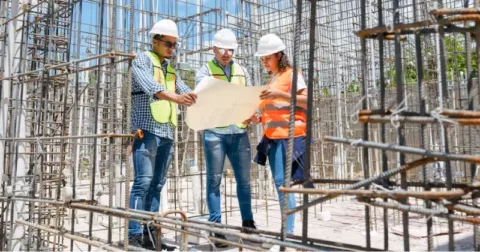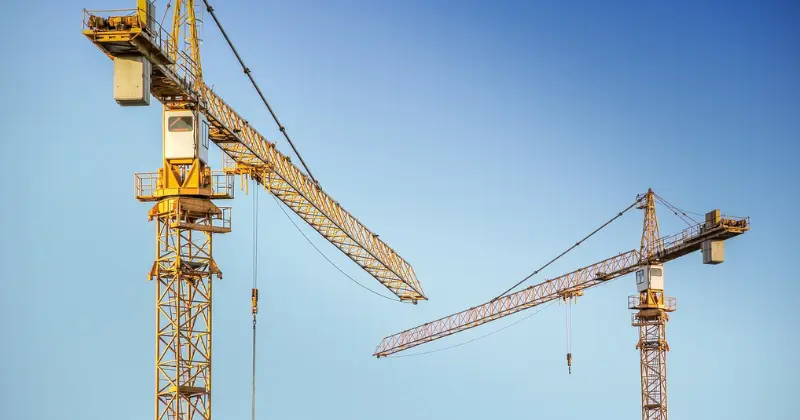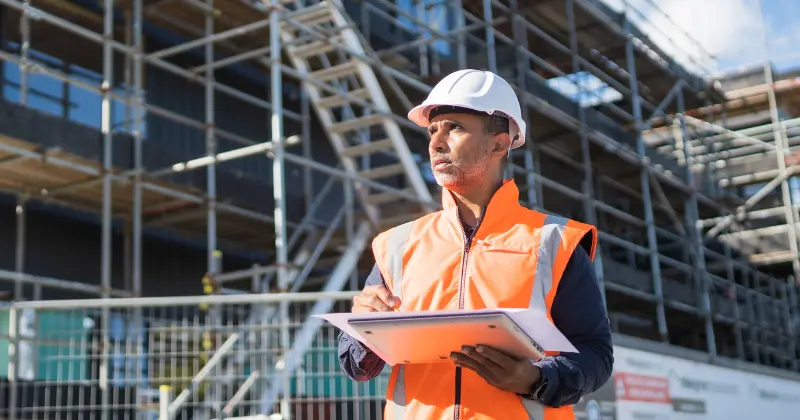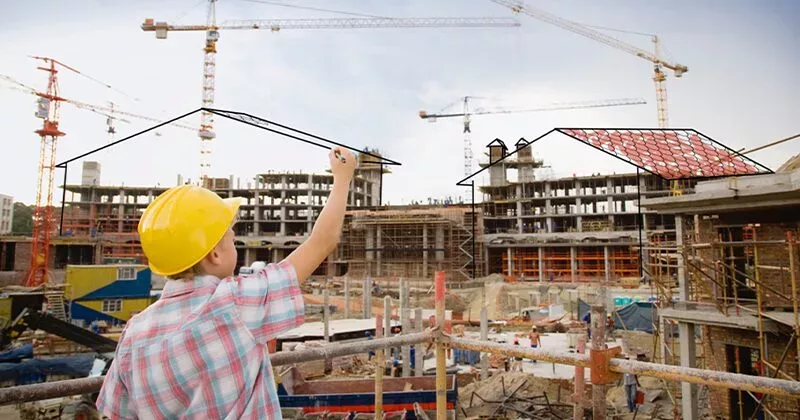10 mins read
Understanding The Importance Of Construction Project Management

- What Is Construction Project Management?
- Construction Project Management Roles
- The Role of the Project Manager in Construction
- Importance & Benefits of Project Management in Construction
- Consequences of Poor Project Management in Construction
- Top 6 Construction Project Management Phases
- Tips For an Efficient Construction Project Management Plan
- Final Thoughts
Experts claim that most big construction projects are not completed on time or budget. However, this inefficient, profit-sapping trend can be vastly improved with proper management and construction software solutions.
A construction project has many moving parts, making managing it challenging. Clear guidelines will help enhance the project’s efficiency and keep everyone on the right track. Understanding the importance of this task and how to support it with the right tools is the basis for success.
In this RIB blog, we’ll tell you everything you need to know about project management in construction. Keep reading to learn the definition, importance, key roles and responsibilities, some best practices, and more!
What Is Construction Project Management?
Construction project management is the process of directing and coordinating human, material, and technology resources throughout a project’s lifecycle. It uses modern management techniques to achieve the expected scope, cost, time, quality, and productivity objectives.
Managing a project in construction is different from other industries because it involves many elements specific to the build environment, such as safety regulations and technology. These elements also change based on the project’s nature, e.g., residential or commercial. Regardless, the goal of project management for construction is to successfully leverage labor, materials, equipment, technology, disciplines, and regulations to deliver a project with the highest turnover.
The process starts with a project’s early development and continues through its final stages. It involves meticulous planning, coordinating, and monitoring workflows to ensure everything is completed on time and within budget.
To do so, the project manager (PM) needs the support of a multidisciplinary team to help ensure every process is completed successfully. Let’s explore some of these roles below.
Construction Project Management Roles
- Project owner: The owner commissions and finances the project. They make high-level decisions regarding budgeting, bidding, technologies, scope, and more.
- Project Manager (PM): The construction project manager, also referred to as the owner’s representative, is considered the leader of the project and is responsible for its overall planning, execution, and closure. Among its many responsibilities, the PM is in charge of estimating and negotiating costs, formulating a budget, managing scheduling, communicating with stakeholders, and much more.
- Construction Manager (CM): The construction manager reports directly to the PM and oversees daily operations on the construction sites, ensuring safety and productivity in all work. They also advise the owner about the quality of materials to be procured, cost estimations, planning, and more.
- General contractor (GC): The GC provides the materials, equipment, and labor required to complete the project and generally manages the subcontractors and other onsite personnel. They differ from construction managers because their role starts after the design phase is finalized and construction begins.
- Contract Manager: As its name suggests, the construction contracts manager oversees all contract-related aspects. They oversee procurement, review, and negotiate deals with contractors and subcontractors, as well as track any changes or claims to the contract. They collaborate with the owner, the PM, and the CM to ensure that contracts meet legal requirements and are accurately executed.
The Role of the Project Manager in Construction
We briefly discussed the different functions of construction management earlier in the post. Now, we’ll discuss the project manager’s role in more detail, as it is the most crucial player in the process.
PMs in construction are not only responsible for managing time, cost, and quality. They are also there to oversee every detail that contributes to the success of their undertaking: a completed project build. Professional construction project manager software helps the PM ensure their team meets deadlines, reaches targets, and adheres to set budgets with the right technology.
Let’s explore some common PM duties and responsibilities below.
Managing time: A key responsibility for any PM is time management. In the leading role, they will have an in-depth view and knowledge about the progress of the project’s different processes, allowing them to move the various pieces to ensure everything runs as expected. The intricate knowledge of the project’s critical path and the ability to report back to stakeholders on the progress of different tasks not only keeps the project within its required timeframe but also maintains a good overview and allows for protective measures to be put in place if needed.
Ensuring project success: As mentioned, the PM takes on the main role when it comes to the following steps:
- Planning
- Execution
- Monitoring
- Control
- Closure
This is another reason why this role is so important. PMs are fully responsible for whether the project achieves its mission with as few snags as possible. However, if problems do arise (this is construction, at the end of the day), the processes and procedures implemented by the PM will assist in rectifying and correcting the mistakes and getting the project back on track to achieve success.
Safeguarding solid relationships through effective communication: The PM is also responsible for ensuring a healthy relationship between the construction company and its clients by regularly reporting progress or issues. Good communication can result in good client-contractor relations that lead to beneficial treatment for any future tenders or projects. It will always do a company well to satisfy the needs and wants of its clients.
Providing a winning formula: When someone oversees many moving parts, they will gain knowledge and experience to help the company optimize future projects. Lessons learned from previous projects are the industry norm, and experience counts greatly in construction. PMs can apply their expertise and training, identify where things could go wrong, and work on how to make amendments or bring positive outcomes from these issues.
Importance & Benefits of Project Management in Construction
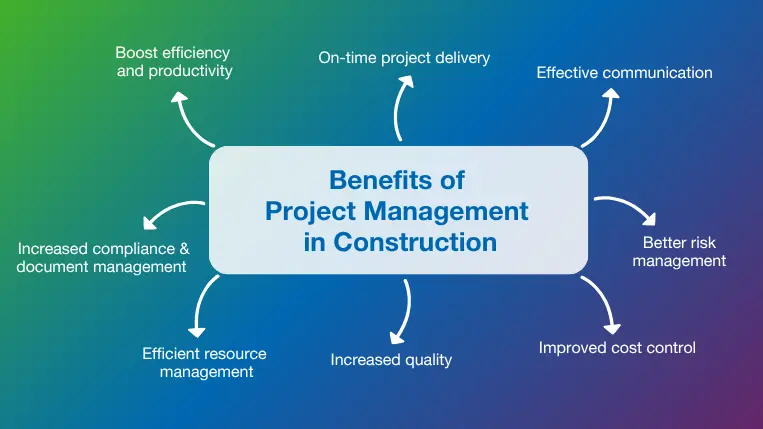
Construction projects are complex processes that involve massive budgets and a lot of risk. The only way to ensure everything is carried out successfully is to manage it correctly. The consequences of poor project management not only involve a waste of money for the owners but, most importantly, safety risks for labor and, in the worst case, risks for the people who will operate the building in the future due to quality issues. Therefore, understanding the importance of construction management and how to do it effectively is of utmost importance for any stakeholder involved in the process.
Below, we discuss some of the key benefits of the efficient management of construction projects.
Boosts efficiency and productivity
A well-thought-out construction project management program helps organize the work to meet deadlines and budgets. This ensures everyone knows what to work on, significantly enhancing construction productivity. Considering the number of people and processes involved in a building project, having an organized schedule of how and when each step should be completed is crucial to meet profitability and quality goals.
On-time project delivery
Completing a project within the expected time is a massive indicator of success, especially considering that only 25% of construction projects are completed within 10% of their original deadlines. Effective management processes, like implementing a detailed schedule with the help of tools like Gantt charts or critical path analysis, can help the PM handle bottlenecks and resolve scheduling conflicts before they can cause any damage. This, together with regular task progress monitoring, can ensure on-time delivery and increased client satisfaction.
Effective communication
Communication in construction is one of the biggest challenges for companies across the industry. During project completion, good management enables owners, architects, engineers, contractors, subcontractors, and others to stay connected and work towards common goals. To achieve this, the PM must select clear communication channels and set hierarchies to ensure everyone understands their role, allowing for a transparent flow of information throughout the project’s lifecycle.
Better risk management
The construction environment is constantly changing and subject to unpredictable situations and risks. Proper management techniques can help predict and identify potential hazards, such as weather conditions or labor or material shortages, and implement preventive measures to mitigate them. A skilled PM can identify potential risks early and plan mitigation strategies to prevent them from affecting the project. For example, setting a contingency budget ensures any potential risks can be covered without affecting the budget. Early foresight of risks also protects the timeline by having planned solutions in place from the beginning.
Improved cost control
Construction projects are extremely expensive, and costs can quickly escalate if not managed correctly. Efficient management, with the help of construction cost control software, helps control costs by performing detailed cost estimations and implementing a budget from which expenses can be tracked and optimized to ensure the project remains profitable. A cost-conscious approach to project management means fewer surprises, better accountability, and alignment with the client’s financial expectations.
Increased quality
Efficient project management ensures all quality standards are met thanks to constant control regarding materials and building code standards. Quality assurance (QA) and quality control (QC) are two of the most important aspects of a project because they directly impact the safety and durability of the final product; therefore, they should be taken very seriously. By aligning work with technical requirements, managing inspections, and coordinating QA/QC teams, the likelihood of defects and rework is significantly reduced.
Efficient resource management
A construction project comprises many resources, including labor, materials, equipment, and tools. All these resources must be procured and allocated smartly to avoid potential issues or delays. For example, equipment and materials must be on-site at the expected time and date to keep the schedule going as expected. At the same time, employees must be available to complete the work on-site. This organized approach, where dependencies are identified and resource requirements are aligned with the schedule, reduces waste, enhances productivity, and ensures effective cost control.
Increased compliance and document management
Effective scheduling, budget control, and resource allocation are just a few pieces of the construction project puzzle. Compliance with legal, environmental, and safety regulations is another huge aspect that is just as important for success. An effective management plan involves implementing systems for document control, compliance monitoring, and safety, ensuring permits are filed and all relevant codes and standards are considered. A clear organization for crucial compliance documents also helps support potential legal disputes, protecting everyone involved.
Consequences of Poor Project Management in Construction
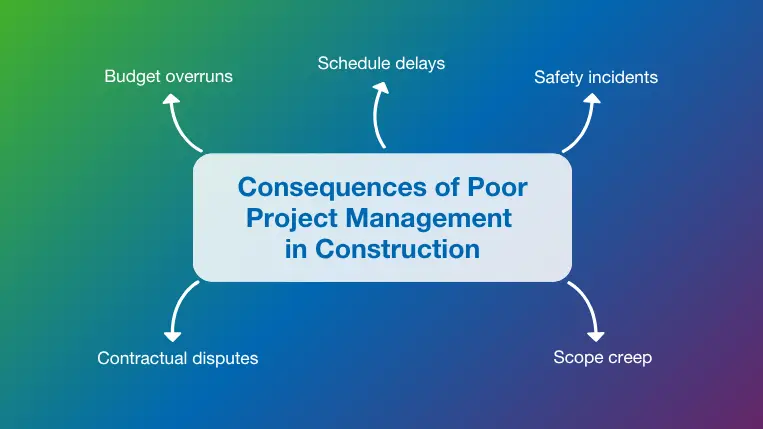
As you’ve learned, the benefits of project management in construction are many, especially for meeting budget, schedule, and quality goals. However, when mismanaged, projects can suffer various issues that can tarnish reputations and lead to legal disputes. Understanding the consequences of inadequate project oversight is crucial for stakeholders aiming to mitigate risks and ensure project success. Below, we explore some of the main implications of mismanagement.
Budget overruns: Bad project management in construction can lead to numerous issues, such as inaccurate estimates, poor budget control, and a lack of coordination between disciplines. Inadequate planning may also cause material delays, idle labor, or last-minute orders at high prices. These can result in costly rework and budget overruns, impacting profitability and client success.
Schedule delays: Another consequence of inefficient planning and coordination between teams and disciplines is schedule delays. As mentioned previously, most projects are not finished on the expected schedule; however, this can be intensified when timelines are not respected or monitored, especially considering that one delay can cause an entire chain effect that will also affect the budget and the company’s reputation.
Safety incidents: This is the most severe consequence that can result from poor management of a construction project. Building sites are full of safety hazards that must be addressed appropriately to reduce the risk of accidents to zero. Construction site accidents endanger workers, cause project shutdowns, regulatory investigations, and an increase in insurance costs.
Scope creep: The concept “scope creep” refers to the uncontrolled expansion of a project’s scope, adding new requirements and deliverables without adjusting the budget, timeline, or resources. This is a direct consequence of inadequate planning and collaboration between stakeholders and can often result in delivery delays and misaligned expectations, not to mention severe impacts on quality and profitability.
Contractual disputes: Poor project management with vague scopes and undocumented changes, misaligned responsibilities, and poor coordination can lead to legal disputes between contractors, clients, and consultants. These disputes can escalate into lengthy and costly battles that add costs to the project and delay its closeout. They can become even more complex when information is not adequately documented to support legal discussions.
Top 6 Construction Project Management Phases
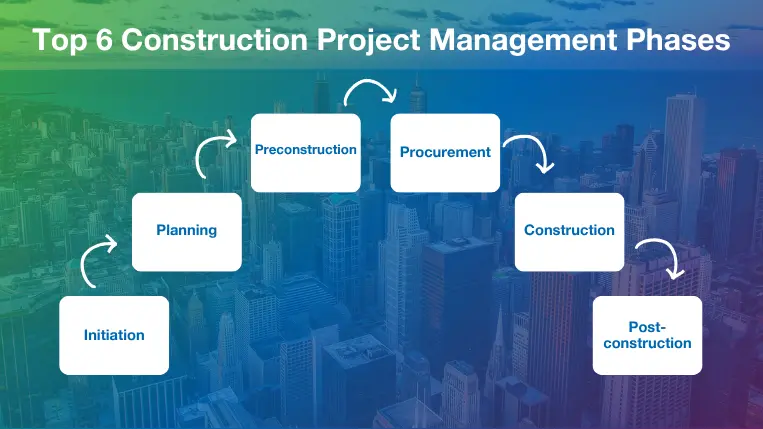
Now that you know a bit about the functions and benefits of construction management, let’s discuss the main phases of the process.
1) Initiation
Also known as conception, this is phase 0 of a project and lays the foundations for everything that will come after. At this stage, the project’s scope and objectives are defined, stakeholders are identified, a preliminary budget is established, and the drawings and construction specifications are rendered in collaboration with engineers, consultants, and architects.
During this stage, owners, in collaboration with a multidisciplinary team, conduct two studies: the feasibility study and the business case. The feasibility study evaluates how doable a project is from a technical and operational perspective. This study highlights potential challenges such as regulatory requirements, budget considerations, site limitations, etc. In the best case, the feasibility study will show the owner that the project needs some adjustments, but it is good to proceed. In the worst case, it will tell them the whole thing is a no-go.
However, a business case evaluates the project’s financial viability, assuming everything is approved from the technical and operational side. This document is used to understand whether the project is worth the investment and to justify its implementation. It outlines the costs, benefits, and expected outcomes.
2) Planning
This stage starts once the project is approved to proceed. Here, the PM selects the delivery method that best aligns with the project’s nature and develops a strategic plan to ensure everything runs efficiently. Some of the tasks involve:
- Outlining all tasks and timelines necessary to complete the project
- Doing a cost management plan and budget
- Allocating labor, material, equipment, and monetary resources to each task and phase on the schedule
- Doing a risk assessment and a mitigation plan
- Defining quality standards and safety procedures
- Defining communication strategies and a single source of truth for all information and documentation
Once that is done, the PM and owner start bidding to select the team responsible for the construction. Construction bid management can vary depending on the type of contract and the project’s scope, but the end goal is the same: selecting a qualified GC.
3) Preconstruction
The preconstruction stage starts once the GC is selected. As its name suggests, in this phase, the team ensures that all requirements and preparations are in place before construction can start. It is a fundamental stage in the process as it helps ensure no details are missed that could affect the project later.
During preconstruction planning, the GC will:
- Conduct a cost assessment that includes construction costs, materials, labor, and services to develop an accurate procurement strategy.
- Secure any permits or regulatory approvals.
- Do a site inspection to confirm that everything stated in the contract is accurate. It is also the first opportunity the GC gets to identify potential issues for construction.
- Create a construction risk management plan and mitigation strategies.
- Set up a safety plan. The owner’s team completes this step, but contractors also take care of it independently since it is essential and, in most cases, life and death.
- Generate a work breakdown structure (WBS) listing all tasks and activities to have a clear outline from start to finish. The PM then takes the WBS and turns it into a schedule with defined milestones to assess progress.
- Set up a communication plan that matches the overall project communication plan. Here, the GC specifies the frequency of communication and the owner’s responsibilities to provide information.
4) Procurement
Once all planning, design, and budgeting are ready, contractors put together a construction procurement strategy that involves bidding and selecting subcontractors and suppliers to ensure the quality standards and goals of the project are met. Sometimes, when the project requires special materials or equipment, the owner begins procurement even before the GC is hired. However, in most cases, the GC is responsible for procuring materials and equipment.
The GC uses construction specifications, including a bill of quantities, to ensure the right quantities and quality of materials, equipment, and labor are procured and shipped on-site according to the expected schedule.
5) Construction
Also known as execution, this is the stage where construction finally begins. Management takes an active role in ensuring all activities and tasks are successfully coordinated and completed according to the timeline, budget, and quality standards. The PM maintains close communication with all stakeholders to assess progress, identify potential issues, and tackle them to ensure the project remains on schedule. During this stage, progress is recorded in interactive reports that every stakeholder can access in real-time, making the workflow more efficient and collaborative.
As construction progresses, unexpected design changes or scope modifications occur regularly. The contractor and PM evaluate the impact of these changes on the budget and project timeline and collaborate with the owner to formulate strategic plans for moving forward. These changes usually involve reallocating resources and changing the original plan while ensuring the final product remains the same.
The correct management of construction projects from the initial stage shines through during execution. All the planning and scheduling done in the previous stages set the groundwork for what will happen in the building phase. With the correct coordination and tools, the project’s result will exceed expectations.
6) Post Construction
Also called project closeout, it is the final phase of the management process. It entails finalizing all construction activities and tasks to close the project formally. During this phase, a construction punch list is generated, listing all small tasks that still need to be completed. A final site inspection is also done to ensure all the completed work meets the drawings, specifications, and quality. Any inefficiencies found in the punch list during the final inspection are addressed and resolved, and final permits are approved by authorities to occupy the building safely.
After the owner approves everything, the contractor can begin closing contracts with suppliers and subcontractors and gathering all the closing documents for the client. After the project is closed, the GC will still be responsible for addressing any operational issues that arise from construction.
The PM will formally review the entire project and gather feedback from the different stakeholders to identify any mistakes and learn from them for future projects.
Tips For an Efficient Construction Project Management Plan
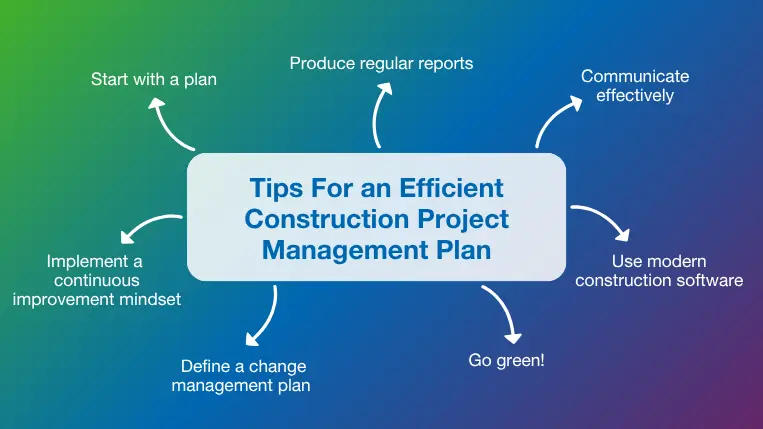
1) Start with a plan
One of the typical project management challenges is arranging everything simultaneously and efficiently. We are talking about setting up a defined schedule, allocating resources, setting quality standards, managing risk and procurement, organizing teams, and much more.
To do so effectively, drawing up a clear project management plan for construction before starting the project is essential. The plan needs to address all the client’s expectations, lay out the different processes, and outline how the tasks will roll out. The proper construction planning software can help you centralize all processes and generate a realistic schedule for each phase.
2) Produce regular reports
Another tip for efficient project management is to implement a construction reporting system to document all developments and progress of the project. The data contained in the reports helps the PM and other team members to inform their most critical strategic decisions with accurate information. We mentioned how important experience is in this industry; however, intuition and knowledge can only get you so far. Data-backed reports provide a single source of truth coming directly from the project operations, making them the perfect tools to identify improvement opportunities and track progress.
Depending on the purpose, project management reports can be delivered daily, weekly, bi-weekly, or monthly. Some information should always be included, no matter the type of construction underway. These critical points include:
- The name of the project, the manager, and the client
- The start and expected end dates
- Contact information for key stakeholders
- The report’s release date
- The current schedule progress is measured against the project’s agreed-upon baseline construction program
- A current cost vs budget comparison or Cost Value Reconciliation (CVR) report
- The current scope compared to the agreed-upon scope
- An updated risk overview
- Updates on any pending or approved change requests (variation orders)
- A summary of key high-level decisions and actions implemented since the release of the previous report
- Upcoming project milestones
- Updated net cost and income forecasts
Some stakeholders may be reluctant to add the reporting element to a construction project. Still, reporting ensures more streamlined processes across the board, which improves the overall execution of the construction plan. By sharing real-time information effectively, project stakeholders can monitor progress and compliance with the plan, allowing parties to address issues quickly, which can help avoid costly delays and changes. Construction management software, such as RIB Candy, houses all the relevant information on one platform and links all processes from planning to the final account, allowing for centralized decision-making.
3) Communicate effectively
We might sound like broken records here, but communication is crucial in many aspects of the successful management of construction projects and is often overlooked. When managing so many relationships and processes simultaneously, efficient communication is the only way to ensure everyone is on the same page and working with updated information. Effective communication helps reduce confusion and ensures workflows move on as planned.
Communicating effectively also helps manage expectations from different parties, a challenge that PMs need to overcome at the beginning of the process.
4) Use modern construction software
In the past, construction project management mistakes were an everyday occurrence. That was not necessarily because the PM needed to do a better job, but because the work was siloed due to substantial communication challenges. Luckily, modern construction software provides PMs and construction teams with the necessary tools to oversee every aspect of the project in a centralized location. Solutions such as RIB Candy offer a centralized platform that supports detailed planning, monitoring, and cost control to ensure resources are allocated efficiently and tasks are completed within time and the expected budget.
Candy’s robust planning module links time and money for effective project management. A powerful critical path network system helps determine the shortest possible project completion time by analyzing and identifying the best sequence for activities and tasks. Resources can be seamlessly added to the program, and progress can be easily tracked for analysis.
The estimating and quantity takeoff modules allow you to perform agile on-screen takeoff to extract quantities directly from project drawings and compile an electronic Bill of Quantities. Bids can be efficiently priced thanks to accurate pricing libraries that make budgeting way easier and precise.
These and various other features for financial forecasting, communication, subcontractor management, and much more make RIB Candy the perfect partner for successful project management in the construction industry. Plus, the software offers a cloud version to access all project data online from anywhere. This makes on-site management much easier and breaks the communication barrier that has burdened the industry for so long.
5) Go green!
RIB’s latest construction sustainability report shows that 74% of surveyed companies have not estimated their projects’ embodied carbon emissions. Considering that the construction industry is one of the biggest polluters in the world, going green is an excellent management practice that will make projects more sustainable and conscious.
When we say, “Go green,” we are not only talking about tracking and managing carbon emissions. Although this is a fantastic practice that all construction companies should implement, other ways exist to make projects a bit “greener.” One way is to think of ways to optimize energy and water consumption during project completion and post-construction operations.
6) Define a change management plan
As mentioned, change is inevitable in construction projects. Unforeseen site conditions, design modifications, or even weather conditions require the project manager to act quickly to avoid impact on the budget and schedule. To prevent these changes from becoming a planning nightmare, defining a robust construction change management plan from the early stages of the project can help navigate changes as just another aspect of the work instead of a massive headache. The plan should outline the procedures for identifying, evaluating, approving, and implementing changes, ensuring that the impact of each change is analyzed in terms of scope, schedule, and budget. It should also outline the roles and responsibilities to ensure accountability and transparency regarding change management, demonstrating a proactive approach to managing potential risks and uncertainties.
7) Implement a continuous improvement mindset
No construction project is perfect. There is always room to learn and improve at least one process for a better outcome. This is why we recommend you follow the continuous improvement mindset proposed by lean construction. This mindset encourages all team members, from management to site workers, to actively participate in finding opportunities to enhance processes, reduce waste, or improve quality. This approach encourages companies to reflect on project outcomes through meetings and discussions, fostering an environment where lessons learned are effectively integrated into future projects.
A continuous improvement mindset ensures that construction firms remain competitive and adaptable. It also boosts efficiency and productivity and enhances stakeholder satisfaction by consistently delivering better results.
Final Thoughts
Managing a construction project efficiently involves widespread duties. Construction management happens from the planning phase to the last brick being laid down. PMs play an important role in project success by keeping everything running smoothly and on track throughout every stage.
For the best results, why not use a built-for-purpose solution that can make project management easier and more efficient? Look at the all-in-one project management software RIB Candy, which will help your project managers boost each project’s success. If you want to experience the power of state-of-the-art construction software, get your free demo for RIB Candy today!
Get My Free RIB Candy Demo Now
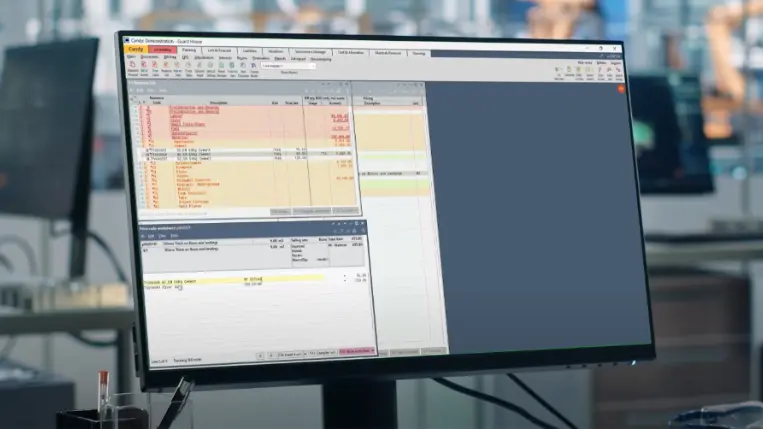
Most Recent
10 mins read
29 mins read
27 mins read
24 mins read
Blog Categories
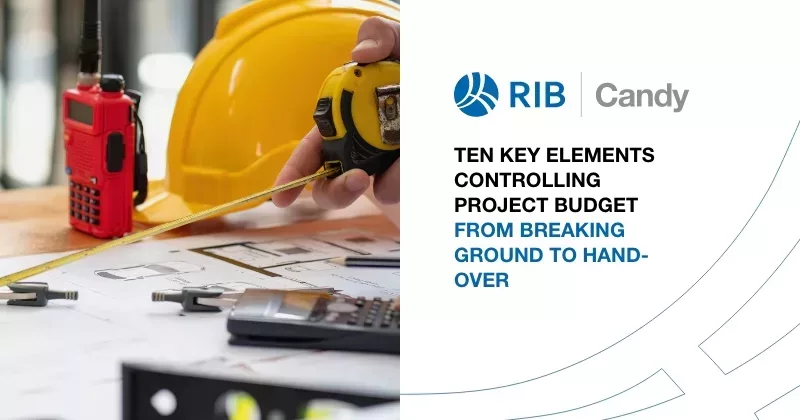
Ebook
